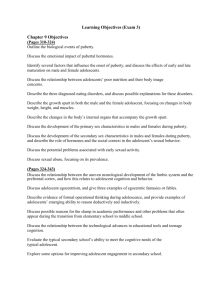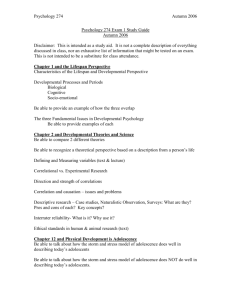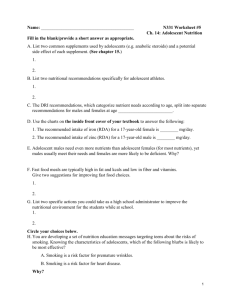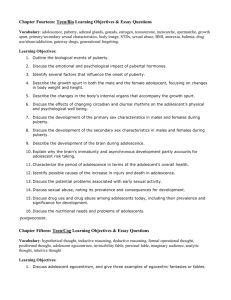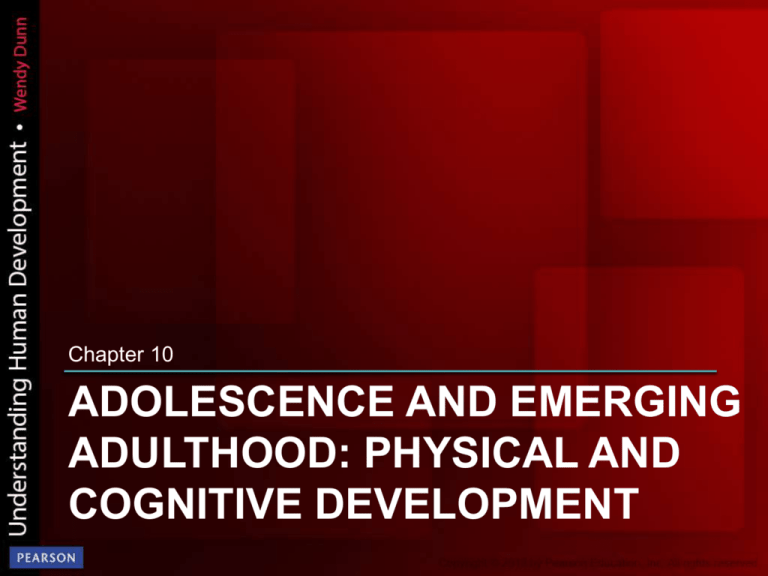
Chapter 10
ADOLESCENCE AND EMERGING
ADULTHOOD: PHYSICAL AND
COGNITIVE DEVELOPMENT
Adolescence and Emerging Adulthood
Physical and Cognitive Development
Adolescent Development in Cultural
and Historical Context
Hunter-gatherer and
agriculturally
societies
• Entrance into
reproductive years
• Often transition ritual
called rite of passage
• Apprenticeship
followed by entrance
into adulthood
Contemporary U.S.
society
• Period between end
of childhood and
beginning of
adulthood divided into
three periods
• Early adolescence
• Later adolescence
• Emerging adulthood
Three Periods of Adolescence and
Emerging Adulthood
Adolescent Development in Cultural
and Historical Context
Adolescence in the U.S.
• Age-segregation
• Prolonged economic dependence
• Mass media
• Instability, uncertainty, and
challenge
Are you an Adult?
Characteristics of Emerging Adulthood
Physical Development and Adaptation
Growth spurt
takes place
Physical
Growth and
Change
Rapid
biological
changes occur
Secondary sex
characteristics
develop,
controlled by
increased
hormones
Physical Development and Adaptation
Male and female hormones
• Both male and female hormones are present in
members of both sexes
• Sex hormones act influence specific set of targets or
receptors
• Balance in production of sex hormones directed by
hypothalamus and pituitary gland
• Hormones may activate specific behaviors at any
point of development through their effects on the
nervous system and trigger emotionality through
their action on regions of brain responsible for
emotional control
Typical Physical Changes in
Adolescence
Physical Changes and Adaptation
Secular Trend
• In many industrialized
countries, puberty
occurs at younger ages
than in the past
• Adolescents belong to a
marginal group on
fringe of dominant
culture
Physical Changes and Adaptation
Eating
disorder
• Body image is of major concern
• Girls worry about being too fat or too tall
• Focus on obesity can lead to eating disorders
• anorexia nervosa
• bulimia nervosa
Prevalence of Obesity by
Race/Ethnicity Among 12- to 19-YearOlds
Physical Development and Adaptation
Early and late maturers
• Boys and girls mature at different
ages
• Girls mature 2 years earlier than
boys, on average
• Late maturation is a disadvantage
for boys
• Early maturation can be a problem
for boys and girls, because
childhood is cut short
• Late maturation can be an
advantage for girls, because then
they are in more in sync with boys
Two boys of the same age
and grade
Six Decades of Changes in Sexual
Practices
Before mid-1960s
Most youth felt premarital sex immoral, but peer pressure often encourage
experiences before marriage
Late 1960s and early 1970s
Premarital sex not inherently wrong for most adolescents
Late 1970s
Sexual revolution in full swing with increase in sexual activity among
adolescents
By 1980s
Sexual revolution fading and variety of attitudes about sexuality, including
more caution
Through 1990s and into 21st century
Cultural attitudes stabilized in U.S. and youth more conservative
Gender Identity and Sexual Practices
Regardless of
generation, emerging
sexuality that is a
biological feature of
adolescence must be
integrated into the
adolescent’s
developing sense of
self-concept
Most people
recognize that many
adolescents will
become sexually
active at some point,
most likely before
they are married
Early sexual activity is
associated with
gender, ethnicity,
family situation, and
age of sexual maturity
Consequences of Adolescent Sexual
Behavior
Sexually transmitted
diseases (STDs)
• About 20% of sexually
active teens have an STD
• By age 24, the number
increases to 33%
• Most common STDs are
genital herpes and
chlamydia
Teenage pregnancy
• About 8% of teen girls
become pregnant
• Pregnancy rate for
teenagers who identified as
Black or Hispanic was more
than twice that for teenagers
who identified themselves
as White
• 30% of sexually active teens
use no contraception
• Rates of teen pregnancy
have fallen 30% over the
past decade
Why Teenagers Become Pregnant
U.S. adolescents are
less likely to use
contraception
Some adolescents are
ambivalent about their
own behavior; others
take a passive attitude
They are novices who
are uncomfortable
about making demands
on partner at times of
high excitement
Teenage Parenthood
Effects of early
parenthood
Teen mothers may drop out of
school, work lower paying jobs,
experience job dissatisfaction, and
become dependent of government
support
Teen fathers may leave school
and take low-paying job to support
new family
Marriage of teen parents generally
does not produce positive
outcomes in part because
marriage leads to school dropout
Children of teenaged parents are
at a disadvantage compared to
children of older parents
Summary of Teen Parenthood
Consequences in the United States
Cognitive Changes in Adolescence
Brain
development
Synaptic pruning takes place
New research using
brain imaging
techniques shows
otherwise
Gray matter (neural tissue) and
white matter (myelin) increase until
about the age of 40
Last area of brain development in
teens is in frontal lobes, where
decision making, problem solving,
and thinking occur
Judgment skills are the
last to develop
Cognitive Changes in Adolescence
Changes in
adolescent
brain
• Second wave of neural pruning and synapse
development and increase in gray matter
• Volume of white matter increases
• Myelination increases unevenly order:
• Regions largely responsible for sensory
functioning
• Brain areas responsible for coordination
• Areas related to complex mental functions
and require coordinated thought and
judgment
Influence of Hormones on Brain
Hormone
influence on
brain
• Target specific areas
related to emotional
regulation and control
(amygdala)
• Increase
neurotransmitter
dopamine causing
dopamine over-activity
linked to risk-taking
and heightened
emotionality
Overall Cognitive Changes
Using abstract
thought
Acquiring more
knowledge
Thinking
metacognitively
Cognitive
development
in
adolescence
Reasoning
hypothetically
Cognitive Development
Thinking is abstract,
speculative, and
independent of
immediate
environment and
circumstances
Ability to form
logical and
systematic
hypothesis is
hallmark
Ability to compare
reality with things
that may or may not
be is achieved
Piaget’s
Formal
Operational
Thought
Expanding Piaget’s View
Information-processing
theories
• Changes in thinking are more
gradual, with shifts back and forth
between formal operational thought
and earlier cognitive modes
• Cognitive development is
continuous process
Hallmarks of Adolescent Cognition
The Scope and Content of Adolescent
Thought
Scope and content
• More breadth and complexity in their
thought content
• Increased ability to understand contrary-tofact situations often affects parent-child
relationships
• Adolescents want to “negotiate” at this age
• Teens show increasing concern with social,
political, and moral issues
What Do Adolescents Do All Day?
Around the world,
adolescence is a period of
social learning and a period
where adolescents restructure
their roles in their societies
Culture is a highly
defining force on how
adolescents choose
their leisure time
activities
Compared to
adolescents in other
parts of the world,
U.S. adolescents
have more
discretionary time
Leisure Time
What is adolescent
egocentrism?
Adolescent Egocentrism
Self-absorption in
understanding own
thoughts, attitudes, and
values leads to
egocentrism
Self imagine as the center
of everyone’s scrutiny—
imaginary audience
Personal fable, the teen’s
belief that he or she is so
special that nothing bad
can happen to them, is
often apparent in
adolescent thinking
Moral Development in Adolescence
Cognitive and brain changes
that occur during
adolescence lay the
groundwork for the
adolescent’s moral
development
Most teens move beyond
Kolhberg’s conventional
stage (at least sometimes),
where judgments conform to
social expectations and
stereotypes
Giving teens more complex
moral issues to consider
creates a disequilibrium that
encourages them to struggle
to resolve contradictions
Older teens may begin to
rely on internalized moral
principles (post-conventional
stage)



